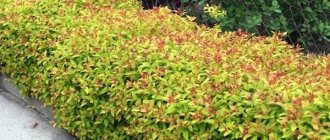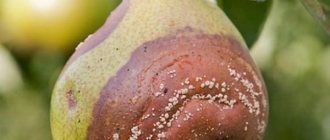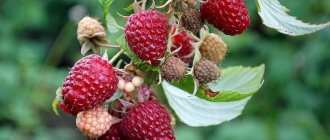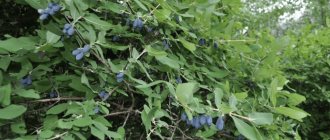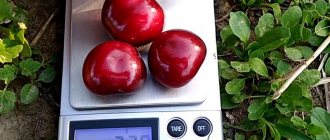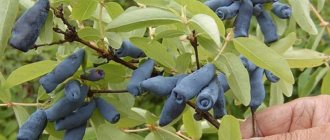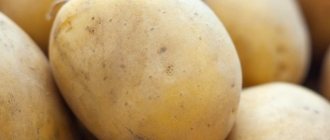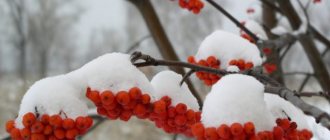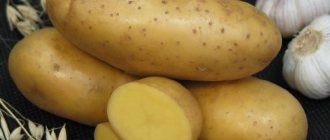Irga alnifolia
The agricultural technology for growing irgi is quite simple, since the plant is unpretentious due to its species characteristics:
- Drought resistance.
- Winter hardiness.
- Rapid growth.
- Precociousness.
In addition to obtaining a harvest of its own berries and excellent honey-bearing properties, the plant can be used as a rootstock for growing dwarf pears and apple trees.
What is irga
Saskatoon belongs to the group of self-fertile plants that do not require cross-pollination. You can also note such popular names of this culture as pirus, wine berry, karinka. You can find other names in different regions, for example, northern grapes, karisha. Sometimes it is called yarga, korika.
The fruits of the serviceberry ripen gradually. The dark blue berries with a whitish coating have a pleasant sweetish taste with a slight astringent note. Low trees or shrubs begin to bear fruit early. The first berries appear already 4-6 years after planting the rooted seedlings. Up to 15 kg of fruits are collected from ten-year-old plants, which can remain on the branches without falling off until frost.
Shrub care
Have you decided to plant shadberry in your summer cottage? You can find out which good variety to choose in the next issue of Summer Resident. Most often, only the varieties listed above will be presented there. By the way, you can borrow them completely free of charge from your neighbors, because the shadberry shoots produce a lot. This is a completely unpretentious plant that will withstand even the most severe frosts.
However, she also has her own requirements for conditions of detention. Irga will survive in any conditions, but it shows maximum productivity on fertile, loamy soil. The plant loves well-lit places, but will grow even in complete shade. He is completely calm about drought. An excellent design idea would be to plant serviceberries along fences. This will give it a special decorative look, especially if the bushes are trimmed beautifully.
Where and how does cinnamon grow?
The homeland of serviceberry is the Caucasus, northern Africa, Crimea, where this plant grows wild. Corinka is cultivated not only on European territory, but also in the regions of Siberia and the Urals.
There are no problems when growing, since the serviceberry is unpretentious. Grows well on various types of soil, including rocky soil. Although it prefers sunny places, it can thrive in light shade. Easily tolerates frosty winters at temperatures down to -50 °C. During the flowering period, it exhibits frost resistance with temperatures dropping to -8 °C.
According to the description, Corinka is a deciduous bush or low tree. They have a developed widespread root system, located at a depth of about 35-45 cm.
The average height of a serviceberry tree varies between 1.5-5.5 meters. The bark of this plant changes color as it matures, from a whitish color to a dark brown tone. Abundant ovate leaves are attached to the branches using petioles up to 14-15 mm long.
White flowers of 3-10 pieces are combined into inflorescences in the form of a straight brush. They bloom by the beginning of May, when the leaves have not yet appeared. The main fruiting period begins in August. It is quite long, so the berries are harvested almost until mid-September.
You can grow currants yourself from seeds. It is easily propagated by root shoots and also by cuttings. The serviceberry tree is distinguished by its rapid growth. Due to the formation of a large number of root shoots, they require annual removal.
Landing
The crop can be planted in open ground in spring or autumn. Experienced gardeners recommend planting in the fall, as in this case the plant takes root better.
For planting, choose a well-lit area. This will prevent the serviceberry from stretching out in search of enough light, and will also promote a bountiful harvest.
Excellent soil for the plant: loamy or sandy loam. Acidity doesn't matter. The plant cannot be planted in areas with high groundwater, since the root system of the serviceberry goes 2–3 m deep, and excessive humidity leads to its death.
When planting serviceberry in the fall, the site must be prepared in the spring. To do this, remove all weeds from the area, and then keep the area fallow until autumn. Before planting, you should dig up this area, and then apply 40 g of phosphorus and potassium fertilizers per square meter. You need to dig the soil to a depth of 10–15 cm.
How to plant
You should not have any problems planting serviceberry, as it is quite simple to do. For planting, choose annual or biennial seedlings. When planting several shrubs, use a checkerboard pattern, keeping a distance of 1–2 m between plants.
The depth of the planting space should be 60 cm, width - 50 cm. The planting principle is similar to planting currants, blackberries, blueberries, gooseberries and honeysuckle.
When digging a hole, throw the top fertile layer to the side; in the future you will fill the root system of the serviceberry with it. Combine the fertile layer with rotted compost and sand in a ratio of 3 to 1 to 1.
Pour 2 buckets of humus, 400 g of superphosphate and 0.15 kg of potash fertilizer into the finished planting site. From the resulting composition, build a mound on which to place the serviceberry seedling.
Spread the roots, then cover them with prepared fertile soil. Lightly compact the soil. After planting, water the plant with a bucket of water, then cover the surface of the soil with a layer of mulch.
Chemical composition and calorie content
Serviceberry berries contain a variety of compounds that have a beneficial effect on the body:
- organic acids (malic variety predominates);
- copper;
- sugar (approximately 11-12%);
- iron;
- coumarins;
- lead;
- flavonoids;
- cobalt;
- carotene;
- sterols;
- phenolic compounds;
- tannins.
Among the vitamins in shadberry, there is a high concentration of ascorbic acid (about 40%). There are also B vitamins and provitamin A.
Serviceberry berries and juice contain a small amount of calories, which makes them suitable for weight loss. The average calorie content per 100 grams of product is 45 kcal. These fruits are completely free of fats and proteins. The glycemic index has a low value of approximately 20 units.
Varieties and types
Corinna is classified mainly by species. Each of them includes one or more varieties of serviceberry. When selecting, pay attention to the zoned varieties.
The most common types of serviceberry:
- spicate;
- Canadian (varieties “Mandan”, “Slate”, “Smoky”, “Honeywood”, “Forestburg”, “Martin”, “Pembina”);
- tree-like;
- spicate;
- profusely flowering;
- short;
- Lamarck;
- smooth;
- pleasant;
- round-leaved (variety "Pearson");
- alder (varieties “Starry Night”, “Northline”, “Altaglow”, “Thyssen”, “Regent”);
- Asian;
- blood red (varieties “Holland”, “Success”).
Useful properties of serviceberry
Considering the extensive list of compounds and elements in the chemical composition that are important for the human body, the fruits of currants are used in folk medicine.
Medicinal properties of irgi:
- antimicrobial;
- tonic;
- bactericidal;
- antitumor;
- immunostimulating;
- sedatives;
- astringents;
- general strengthening;
- anti-inflammatory;
- antioxidant.
The beneficial properties of delicious cinnamon berries manifest themselves in cleansing the body of slag deposits, heavy metal salts and harmful toxins. Thanks to pectin, these fruits reduce cholesterol levels.
Other healing properties are also known:
- increasing immunity;
- strengthening vascular walls;
- decreased blood clotting;
- preventing blood clots;
- healing of scratches and wounds;
- strengthening gums;
- maintaining visual acuity;
- improvement of brain activity;
- decrease in sugar concentration;
- increased performance;
- normalization of gastrointestinal tract functions.
Currant is useful for the nervous system, helping to strengthen it, relieve symptoms of depression, and eliminate insomnia. Analyzing how shadberry affects blood vessels, increases or decreases blood pressure, it can be noted that traditional medicine recommends consuming the juicy berries of this plant for hypertension. This is due to their ability to lower blood pressure.
An infusion of flowers is used for heart failure. The medicinal properties of a decoction of the bark are known, which, when applied externally, helps accelerate the healing of burns and wounds. This remedy treats sore throat, bedsores, and periodontal disease.
The varied benefits of shadberry allow it to be used for the following pathological manifestations:
- stomatitis;
- varicose veins;
- avitaminosis;
- vegetative-vascular dystonia;
- tonsillitis;
- atherosclerosis;
- liver and kidney diseases;
- diarrhea;
- myocardial infarction;
- cold;
- viral infections.
Northern grapes provide benefits to the male body, increasing reproductive functions. The fruits of this unpretentious plant are used for men to prevent impotence and the development of prostatitis.
There is a beneficial effect of irgi on the female body. Fresh berries or in the form of infusions and decoctions are beneficial for women, reducing severe pain during menstruation.
Features of reproduction
For propagation of irgi they use:
- seeds;
- cuttings;
- layering;
- root suckers.
Spring and autumn (in the year of seed collection) are ideal for planting seeds. In this case, before spring sowing, the seeds should be pre-stratified. The first shoots can be expected in the fall, or, in extreme cases, next spring. The seedlings are transplanted to a permanent place after 2 years.
It is best to cut shrubs in summer. This method allows you to obtain seedlings faster than others, since the next year small bushes with a branched root system grow from the cuttings.
To propagate a plant by layering, you need to bend a branch to the ground and lightly dig it in. It is recommended to do this in early spring, immediately after the soil warms up. Then next spring it will be possible to separate the rooted cuttings from the mother bush.
Thanks to the formation of powerful root shoots, the serviceberry bush forms many shoots. To obtain high-quality planting material, it is enough to carefully cut off a shoot from the bush, capturing part of the root. It is better to plant root shoots in a permanent place in autumn or spring.
Possible harm and contraindications
When consuming serviceberry berries, it should be taken into account that there are specific contraindications for them:
- personal intolerance;
- hemophilia;
- low pressure;
- epilepsy;
- acute phase of infectious diseases.
Strong sedation may be harmful to people behind the wheel. It is not recommended to eat fruits at the same time as milk, so as not to provoke intestinal disorders. It is important to limit the amount of tasty berries on the menu if you are prone to obesity.
Application of fruits
Given their excellent taste and beneficial properties, serviceberry berries are used not only in folk medicine, but also in cooking, as well as home cosmetology.
Jams and jellies are made from them. You can make jam, jam, juice, jelly. Richly colored fruits serve as raw materials for homemade liqueurs. Berries can be frozen or dried. In the winter season, it’s easy to make a fruit drink from them, cook a compote, or make a healing infusion or decoction.
The greatest benefit can be obtained if you consume the currant in its fresh state. It is important to pick berries in an environmentally safe place. They must be washed. It is recommended to eat 450-500 grams of shadberry per day.
Thanks to currant masks, oily skin will look fresh and well-groomed. Grind sufficiently ripe washed fruits and distribute the pulp evenly over the skin. Wash off after 30 minutes. Such procedures are practiced every six days.
Analyzing the benefits and harms to human health of the pleasant-tasting sweetish serviceberry fruits, it can be noted that they should be included in the diet. The healing qualities are especially evident in fresh berries, but currants can be prepared for future use. It is important to consider potential contraindications to avoid negative consequences.
Diseases, pests
Irga is resistant to diseases and pests, but sometimes it is overtaken by tubercular disease. The disease leads to drying out of the leaf plate, and it also affects the branches. To combat tuberculosis, it is necessary to remove weakened leaves and shoots, and treat the sections with 1% Bordeaux mixture (copper sulfate can be used as an alternative).
Phyllostic blotch appears as brown spots on the leaves. To combat the disease, Bordeaux mixture 1% should be used. It is important to remove affected leaves in a timely manner!
If a tree or shrub is overtaken by gray rot, mold spots appear on the leaves. The disease cannot be treated. It occurs if the crop was planted in unsuitable soil (in a place where groundwater lies).
Gray mold is also associated with waterlogging. To avoid illness, you need to add water in moderation. For prevention, you can use Bordeaux mixture and topaz. It happens that the shadberry is attacked by pests. They feed on fruits and leaves, as a result of which the garden crop dies. To get rid of caterpillars and moths, you should use Karbofos.
The irga plant will not take much time; planting and care in the Moscow region must be correct, and, importantly, timely. The crop grows well in open ground if it is watered in moderation. Remember that overwatering is harmful! Apply fertilizers 1 - 2 times a season, then the plant will bloom and bear fruit better.

